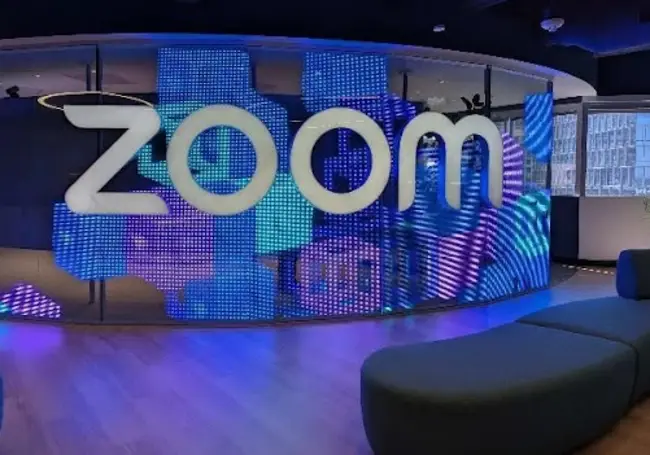Zoom recently held their analyst-only event - Perspectives 2025 - at their San Jose headquarters, and shared a wide range of updates and aspirations for the company. With analysts being the sole audience here, we get a more direct experience than the go-go environment of a customer event, where the messaging is geared more for buyers and partners.
Having followed Zoom for some time, their evolution has been really impressive, especially during that last two years with their embrace of AI. I would contend that no communications vendor benefitted more from the pandemic than Zoom, as they had the right technology at the right time to enable work-from-home.
Microsoft was really the biggest winner from the pandemic, as their strategy to offer Teams for free paved the way for them to dominate the UCaaS space. However, they were already a household name, whereas Zoom was just one of many cloud providers at the time, but they broke through in a way nobody else could - and they’ve been setting the pace for innovation ever since.
That commitment to innovation was on full display at Perspectives, and to give you a sense of that, I’ve distilled the event takeaways into three themes - capturing the AI growth opportunity, becoming AI-first, and leading with CX.

Theme 1 - Capturing the AI Growth Opportunity
Founder and CEO Eric Yuan set the tone for Perspectives with some brief opening comments. He’s an engaging speaker, and I wish he spoke longer, but his positioning was clear - to “capture the growth opportunity” coming with AI. During the pandemic, the growth opportunity for Zoom was about video calling and meetings. More recently, it would have been about entering the contact center space, especially after their bid to acquire Five9 didn’t work out. The company has been very successful on both those fronts, but now it’s about the bigger picture.
AI is transforming every aspect of work, and as Zoom strives to become “AI-first” (as all vendors in this space are trying to do), the building blocks of UCaaS and CCaaS become the foundation for the broader opportunity that AI is enabling. The essence of work itself, along with the workspaces where work gets done, is up for transformation with AI, and you can’t get there focusing solely on UCaaS or CCaaS.
Kim Storin is their new CMO, and she talked about bringing the “swagger back to Zoom”. This is more than great energy to get Zoom out in front of the wave of disruption that AI represents. It’s also about building on the inner confidence Zoom sees for itself in a market that has no de factor AI leader - this opportunity will be collectively shaped by all the vendors, rather than displacing one player at the top.
Given the successes Zoom has had to date - along with their intense focus on AI - they have the “right to create a new narrative”, as we heard from Amy Roberge, Head of Global Contact Center Solution Engineering during another session.
Everyone knows this growth opportunity will be massive, and Zoom believes the company is as well-positioned as anyone to become a leader. It’s important to note here that this “swagger” isn’t about Zoom being arrogant. Emerging technologies are usually supply side-driven, where the vendors need to hype the market up to create demand, often where none existed before.
There is certainly some truth to that with AI, but we heard plenty of examples from Zoom’s leadership where they’re seeing demand now from customers. That’s a far better barometer that makes this “growth opportunity” real, and provides a more credible rationale for Zoom’s confidence in addressing it.
The best example came from Nick Tidd, their Head of Global Channel. He’s only been with Zoom 11 months, but he’s a seasoned channel pro, and the company recognizes the importance of developing the best channel program possible. If this growth opportunity is as big as everyone expects, Zoom cannot capture a leading share alone - it needs to be channel-driven.
Not only is the channel the best way to accelerate growth at scale, but these partners are the feet-on-the-street that has the pulse of the market. Zoom attributes a lot of its success to being customer-centric, and listening closely to what’s most important. Eric Yuan has long talked about wanting “happy” outcomes, and with technology that’s easy to use, customers will have happier experiences.
Nick Tidd talked about how partners want Zoom to “teach me how to sell AI” - because customers want it now - the demand is already there. In terms of capturing the AI growth opportunity, Zoom seems to have a solid game plan here - now, it’s just a matter of execution.
Theme 2 - Becoming AI-First
This is really an extension of the above theme, but it’s important to consider in its own right. “AI-first” seems to be a necessary condition for success for all tech vendors now, and could quickly become table stakes where differentiation is difficult to demonstrate. Zoom’s customers aren’t buying from them because they’re an AI company - they buy because their platform addresses specific business needs. AI is a great enabling technology, but to have value, it must drive outcomes for workers and end customers.
Xuedong Huang is their CTO, and while his vision is to have “the best AI-first platform”, it only resonates when talking about outcomes. Without getting technical, he focused on “agentic retrieval”, where AI’s power comes from being able to retrieve relevant data - in real time and in a fully automated fashion - to facilitate task completion.
This is where the AI story becomes bigger than UCaaS and CCaaS. As with the other vendors, Zoom is already very adept at using AI in these areas. With UCaaS, AI Companion does real time transcription/translation, meeting summaries, generate email responses, etc. For CCaaS, AI Companion is being used for intelligent call routing, post-call summaries, self-service automation, etc.
A more comprehensive form of AI-first involves automating tasks, workflows, processes, etc. - and orchestrating them end-to-end across the organization. This is about breaking down silos where data resides on islands, but not connected or accessible to others parts of the business. Much of the data needed for “task completion” comes from our everyday interactions - our conversations - both voice and text-based.
In this context, Xuedong talks about “conversation to completion”, where the data inputs from conversations inherently have limited value - but when managed by AI, they have a new layer of value when applied to task completion. This takes automation to a higher level, where work itself becomes transformed, and human workers will need to coexist with various forms of AI.
For Zoom, being AI-first means being able to capture inputs from all those conversations to support the agentic capabilities of AI to transform work. Their footprints with UCaaS and CCaaS provides access to most of these conversations, both among workers, and with customers. Note taking is one of many features from their platform to gather these inputs - not just within Zoom, but from third party platforms - to help AI Companion use reasoning and memory to go from conversation to completion.
This form of agentic AI brings new value for transforming work, and being an open platform, Zoom supports a developer ecosystem for an ever-widening range of capabilities. The key here is AI’s ongoing evolution, and with AI Studio, developers use these tools to keep building AI agents to perform ever-more specific tasks with specific data sets. This allows businesses to develop agentic workflows that are specific to their vertical, and even for their region, and even down to a specific department or line of business.
In this regard, AI-first means being both horizontal across the organization, but also vertical within a LOB. Succeeding on all these fronts takes resources, and Xuedong seems to be getting plenty of that to support his AI-first gameplan. In 2024, 17% of Zoom’s revenues were spent on R&D. Not only is that level higher than most of their competitors, but in absolute terms, this translates to $852 million, which will drive a lot of innovation anywhere.
Theme 3 - Leading with CX
Before considering AI here, it must be said that Zoom has done an admirable job of building out their own CCaaS capability in the aftermath of trying to acquire Five9. Knowing that CX is a stronger growth opportunity than UCaaS, they recognized the importance of owning the CCaaS stack, and the numbers validate the success they are having in this space. Most of this was under NDA, but I can say that their contact center customer base is up well over 50% from last year, and they recently won their biggest deployment ever - five figures for number of agents.
Having bet right on build-versus-buy for contact center, it’s not surprising to see their confidence with becoming AI-first, and their “right to create a new narrative” around the above themes. A key part of this is how they view the market. While momentum remains strong for CCaaS, they see CX as part of a bigger picture, and that’s the opportunity they’re really after. Michelle Couture, Global Head of Product Marketing, framed this as not just “disconnected contact center, but disconnected CX”.
Yes, contact centers need help modernizing, and Zoom helps them do that. The larger issue is one of getting a full picture of the customer journey, and that can only be done by drawing across silos as outlined earlier. Otherwise, everything remains fragmented, and contact centers will never be able to provide the CX that both customers expect and senior management is now demanding.
Again, this comes back to turning conversations into insights, as well as providing connected customer journeys. On a branding level, this is reflected by the name change from Zoom Contact Center to ZCX - Zoom CX. It’s more than a name, though, as it speaks to the need for both better agent experiences, and better employee experiences. To provide great CX, contact centers can no longer operate in isolation from the rest of the organization, and a key part of Zoom’s messaging is how they bridge all of this.
The details are extensive, and would require a separate analysis from this article. During Perspectives, Chris Morrissey, GM and Global Head of Sales and Go to Market, reviewed all of this with our group. He framed this as their “Five Pillars of Connected CX”, as per the visual below.
Much like the way Nick Tidd outlined a detailed plan for how Zoom will now work with partners, this framework shows an intentional approach for Connected CX. Not only will this help keep their momentum strong in the contact center space, but it aligns well with the AI-first theme outlined above.
Conclusion
As analysts, we get a front-row seat to see what the leading companies and their executives are doing to be successful, along with how AI is shaping their business. We can’t share everything from these sessions, but the three themes herein provide a good overview for the current state of play with Zoom.
They still have their “happy” vibe - which does set them apart, making Zoom a likeable alternative to the Big Tech giants. More importantly, though, is how you think about the company. They are clearly well beyond video, meetings and contact center, and the sooner you see the bigger picture, the easier it will be to understand their AI-first focus.







Comments ( 0 )